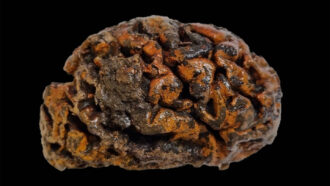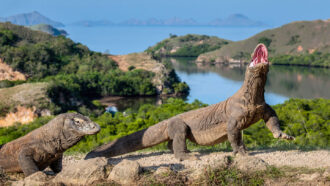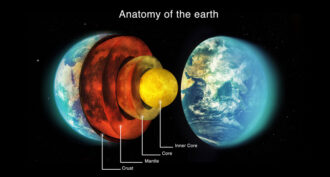 ball from a brown mound. A green baseball field surrounds him below cloudy skies" width="279" height="186" />
ball from a brown mound. A green baseball field surrounds him below cloudy skies" width="279" height="186" /> ball from a brown mound. A green baseball field surrounds him below cloudy skies" width="279" height="186" />
ball from a brown mound. A green baseball field surrounds him below cloudy skies" width="279" height="186" />Curved teeth could grip fragile shoulder tendons without tearing, making rotator-cuff repairs stronger and more likely to last.
By Claire Yuan 22 hours ago
A controversial study suggests that ancient people might have used one to hoist the stones used to assemble into King Djoser’s pyramid.
By Bruce Bower September 3, 2024Atmospheric chemistry is the most important factor in determining which meteors leave behind these persistent trails.
By Lisa Grossman September 2, 2024
A separation — and later recombining — of Earth’s magnetic field lines may be what churns up these super-high-altitude storms of plasma.
By Carolyn Gramling August 30, 2024
More research is needed on ways to safely remove some CO2 from the water to make room for more — such as by seaweed farming and iron fertilization.
By Carolyn Gramling August 29, 2024
The differences between the rods and cones in our eyes explain why objects seem to vanish in the dark when we look at them.
By Roberta McLain August 28, 2024
Ancient brains may not be rare finds. An analysis of over 4,000 preserved human brains reveals five processes that protect against decay.
By Carolyn Wilke August 27, 2024
The last woolly mammoth herd experienced a drop in genetic variation. But this is likely not what doomed these majestic beasts to extinction, new data suggest.
By Claire Yuan August 26, 2024
Investigating Komodo dragons' ironclad teeth in greater detail could also help solve a dental mystery in dinosaurs.
By Erin Garcia de Jesús August 23, 2024
This space telescope could reveal much about the formation, makeup and evolution of distant exoplanets.
By Elise Cutts August 22, 2024
With an offer of a nectar meal, ferns and flowering plants have been bribing ants to fend off predatory insects — since before the rise of T. rex.
By Katie Cottingham August 21, 2024
Founded in 2003, Science News Explores is a free, award-winning online publication dedicated to providing age-appropriate science news to learners, parents and educators. The publication, as well as Science News magazine, are published by the Society for Science, a nonprofit 501(c)(3) membership organization dedicated to public engagement in scientific research and education.
© Society for Science & the Public 2000–2024. All rights reserved.